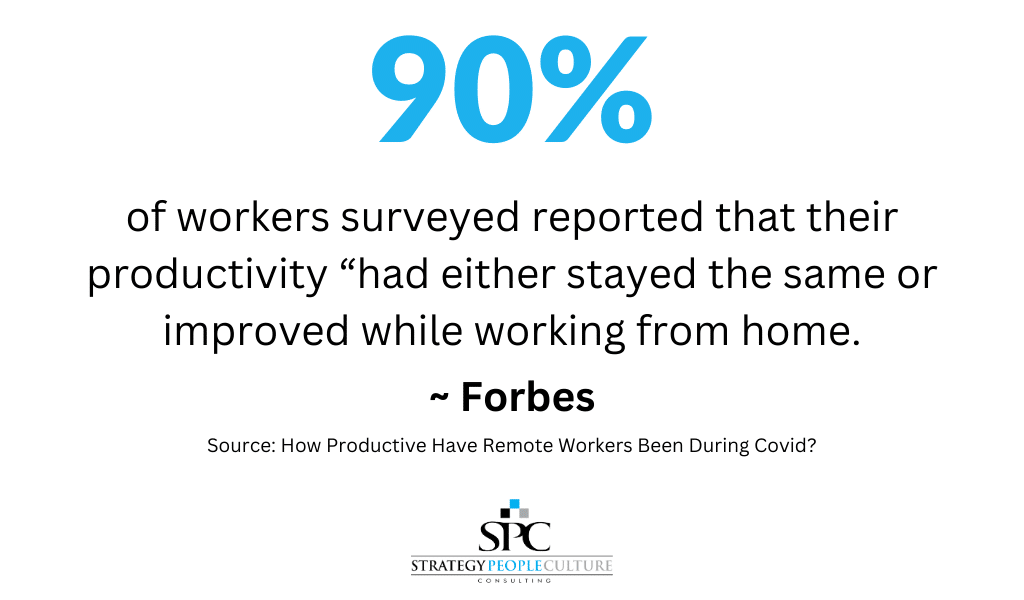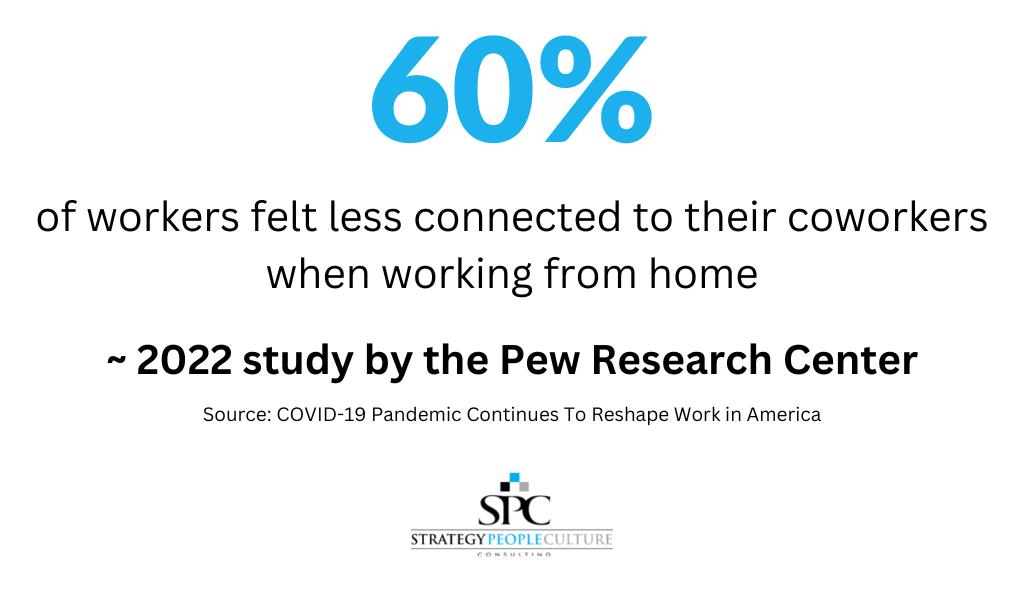Business and Leadership Lessons Learned from the COVID-19 Pandemic

Work and the culture surrounding it change with the times we live in; never in the modern era, though, has there been a change so sudden and unprecedented as the onset of the COVID-19 pandemic in March 2020.
COVID-19 was declared a pandemic on March 11, 2020; less than a week later, policies mandating lockdowns swept the United States (and many nations around the globe). To curb the spread of the disease, lockdown procedures mandated the closure of any workplaces where an in-person operation was not deemed “essential.” Thousands upon thousands of workplaces were shut down for months until the first re-opening efforts began late that summer.
Workplaces and corporate teams had to adapt rapidly and with very little warning. By May of 2020 – less than three months after the pandemic crisis was officially declared – 43 percent of all employed people were working online, as well as 65 percent of white-collar office workers.
Despite this radical and wide-reaching change in the structure of work, not to mention the unstable times in which it occurred, workers’ productivity and output remained consistent (and in some cases increased) with pre-pandemic levels. The transition to work from home, once seen as impossible by some, was now even beneficial to some places of business.
Regardless of whether remote working has been good or bad for business, it’s a poignant example of how leaders who do not challenge themselves beyond their comfort zones and past experiences may be missing opportunities for competitive advantages. That said, how were companies able to so successfully implement something seen as impossible, and what can this teach us about challenging the status quo in our approaches to the workplace going forward?
When Working From Home Was “Impossible”

Before the COVID-19 lockdown, many corporate leaders largely debated and debunked working from home. According to the National Council of Compensation Insurance (NCCI)’s Q4 2020 report, “Before the pandemic, only 6% of the employed worked primarily from home, and about three-quarters of workers had never worked from home.” These statistics were measured in 2019, the last year before the pandemic’s effects took hold.
The reason working from home was so uncommon before the pandemic’s first lockdown wasn’t because the technology didn’t exist; Zoom’s video conferencing service, for example, debuted in 2012. Offices stuck to a traditional setup because of conventional wisdom, which tells us that employees’ physical presence in an office is essential to maintaining a workplace’s culture and productivity, along with employees’ performance and cohesiveness with each other.
Additionally, many business leaders believed that without direct supervision, employees would have lower productivity rates and lack a strong focus on their job and performance. Employers even resisted offering the option to work from home for employees who couldn’t go to the office for reasons like a physical disability. It’s safe to say that remote work was something the business world was not ready to experiment with before there was no other choice.
How The Impossible Became Possible: Meeting the Challenges of Managing Remote Teams

Despite these reservations, work from home was successfully implemented on a wide scale in 2020; and incredibly quick to boot. According to the NCCI, by that May, “over one-third of the employed worked at home.”
Within the first few months of the transition to working online, many long-held beliefs about the barriers to internet-based working were proven to be overblown. Here are three major examples:
1) Fears of Lack of Productivity vs. Reality of Worker Productivity

Although worries about an “out of sight, out of mind” attitude when employees worked from home were pervasive even during the pandemic, across multiple studies, worker productivity was found to be higher when employees had the option of working from home – about 7% higher on average.
In a study by Forbes, 90% of workers surveyed reported that their productivity “had either stayed the same or improved while working from home.”
Part of this was due to employees devoting the hours usually taken up by their commutes to putting in more time working. Workers also attributed the ability to stay productive during the pandemic to strong and motivating leadership in their companies.
2) Fear of Distraction vs. Reality of Commitment
Despite studies confirming employees were experiencing the expected distractions – such as household responsibilities and children demanding attention – teleworkers prioritized finding workarounds to these, adjusting and improving their individual time management, and maintained commitment to their jobs. This was true even without the in-office employee monitoring corporate leaders thought they would need to keep their teams focused.
3) Fear of Alienation vs. Reality of Collaboration
One common fear of working from home was that remote teams would have a hard time staying on the same page. This concern wasn’t entirely unfounded – a 2022 study by the Pew Research Center reported that 60% of workers felt less connected to their coworkers when working from home.
Workplaces and leaders have found inventive ways around this issue. For example, as reported in Time Magazine, Robert Fenton, founder of Qualio, embraced remote work early in his company’s lifespan. He focused on keeping his worldwide team motivated and connected with online meetings and utilized software like an active Slack chat with channels for casual conversation as well as those dedicated strictly to business to recreate the social office environment and virtually create an intentional corporate culture. In Fenton’s view, remote communication is “different but not necessarily inferior” to the office, and the transition between working in person and online is comparable to “learning a new language.”

Fenton’s is just one example of how collaboration is possible with remote work as long as management adopt the right strategies to keep their teams connected and motivated. The same principles make a good leader, whether in person or online; in fact, the qualities of a strong leader are more important than ever to keep a team focused and motivated without relying on the office and its culture to set the tone and keep the pace.
The Unexpected Results of Unthinkable Strategies

As we’ve seen in the last section, many fears held by workplace leaders that working from home would be impossible for their teams were either never realized or had effective workarounds. Additionally, working from home worked best when the boss was an effective leader who knew what decisions were best for their team.
Not only were many of its downsides mitigated, but remote working brought unexpected advantages. One benefit to a remote workforce is evident in companies’ bottom line. Online work has translated, for some businesses, into an increase in revenue.
According to Forbes, here are four main contributing factors:
1) Cutting Overhead Costs
Leading a team remotely rather than in the physical office “eliminates overhead costs like lease expenses, office furnishings, utilities, insurance, supplies, upkeep, and repair,” Forbes reports. While these may seem incidental on their own, a study by Global Workplace Analytics reports otherwise; for IBM, a switch to remote work added up to $50 million saved just slashing costs associated with real estate, and that ” Average real estate savings with full-time telework is $10,000/employee/year.”
2) Increasing Employee Productivity
As we’ve seen in previous articles on our blog, increased employee satisfaction leads to higher productivity. Many employees prefer the greater control over their work-life balance and flexibility in their schedules that working from home affords them.
Employees at home are also working more; Pew Research Center reports that a third of remote workers “…who are working from home all or most of the time say they are working more hours than they did before the coronavirus outbreak.”
Another way remote work increases employee productivity is by allowing employees to work during the hours when they are most productive instead of being stuck to their office’s hours of operation. Some employees are logging on later but getting more done than they would have at a traditional nine-to-five.
3) Increasing Employee Retention
A satisfied employee is motivated to stay committed to their company. Remote work has been incredibly popular among employees; many prefer it to traditional work, and some would even accept a lower salary in exchange for the opportunity to work remotely.
Employee retention is important to a company’s bottom line; according to Global Workplace Analytics, “Losing a valued employee can cost an employer $10,000 to $30,000” and “46% of companies that allow telework say it has reduced attrition.”
4) Hiring The Best
Remote work allows companies the opportunity to find the best talent for their needs rather than remaining constrained to candidates within commuting distance of their in-person office space. As we’ve seen before, the 80/20 rule says that 80% of the work is done by 20% of the people. Hiring the best talent can help balance that ratio and increase ROI for each employee.
How Can A Good Leader Adapt?

As we’ve seen above, it’s the same skills that allow a leader to succeed on the well-established path that help them excel when trying new things that go against the status quo. Here are four examples of how the strengths of a good leader in the physical office translated to a good team leader over the internet:
1) Trust
A big difference between a good leader respected by their employees and one who does not have confidence is trust; the leader believes in what they are doing and that they have the best interests of their team at heart when making decisions. One way to develop this trust is to be your authentic self. Genuine motivation in a leader will inspire a team to feel the same.
2) Communication
Communication involves both being clear in your messaging and in being an active listener to the feedback from your employees. This creates a clear two-way street for both parties to be their most effective. Employees that feel heard are more likely to offer their best ideas and stay committed to their team and workplace.
3) Adaptability
To be adaptable in business means having executives who embrace out-of-the-box thinking to adapt their business to the changing times and circumstances of the world. Good leaders are innovative and responsive to these challenges.
4) Agility
While adaptable leaders can respond to sudden challenges, agile leaders can do this quickly. Leaders who rolled with the punches as they came during COVID were more successful than those who resisted the changes or were slow to change their approaches in response to them. As Forbes reports, COVID-19 taught business leaders that they “must learn to quickly adjust their behavior, pivot company strategies, learn new skills, shift from physical to virtual, and take on new responsibilities at a moment’s notice.”
The Importance of Executive Coaching in Challenging the Status Quo
As we’ve seen through the example of working from home, oftentimes, what conventional wisdom may deem impossible is actually something that can be beneficial or even give your business a competitive edge.
Good leaders challenge conventional thinking to see where unconventional approaches can give them a competitive advantage. Here at Strategy People Culture, we have been helping corporate leaders for over 10 years. Call us at (833) ROCK – SPC or (833-762-5772) or email us at info@strategypeopleculture.com for more information.
